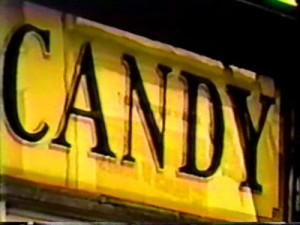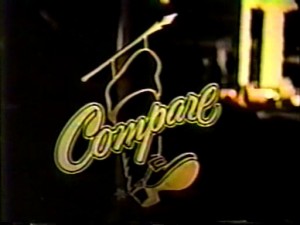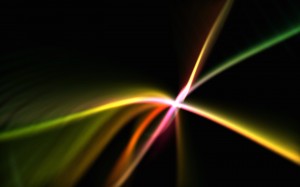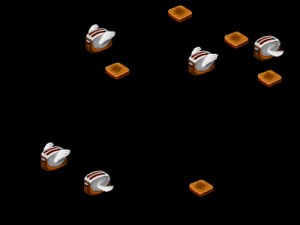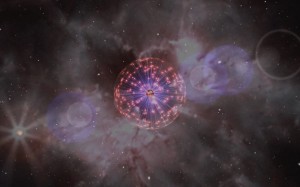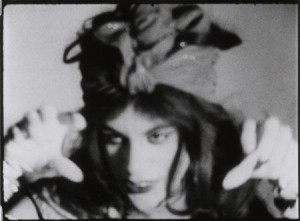Project Arts Centre presents
Nina Beier, Feidlim Cannon and Aurélien Froment
To coincide with Exhibitions, our current exhibition in the gallery, Nina Beier has collaborated with Aurélien Froment to produce Repertoire on Selected Films and Screen Savers, a four-day film and performance programme in the Cube. Froment has selected a series of films whose structures generate a dialogue with the ideas surrounding Exhibitions, and specifically Nina Beier’s previous performance Repertoire, previously exhibted at Art Statements, Basel, 2010.
The details of the programme will begin to unfold when actor Feidlim Cannon, of Brokentalkers, performs a voiceover which consists solely of memorised lines from previous performances throughout his history as an actor. His unscripted performance will organically evolve in response to the flittering, projected characters and images of the films of Jean Comandon, Jean Painlevé, Andy Warhol and Hollis Frampton. Seated somewhere amongst you, his voiceover bridges the gap between screen and audience, where the process of identification or projection, revealed during the cinematic experience, mutates and transforms to be as much directed towards the screen as with your neighbour.
Film screenings and performances will change nightly to both explore and illuminate an intense exchange of gazes between projected figures and the Cube’s audience (Screen Test #2); a dialogue generated by the play between screened and improvised forms of language and image (Zorn’s Lemma) and finally close with The Best of Screen Savers, Ever – a performance best left unexplained but definitely not missed!
WEDNESDAY 27 OCTOBER, 7PM
Jean Comandon, La Croissance des vegetaux (The Growth of Plants), 1929
One of the first to use the techniques of cinematography to study biological phenomena, Comandon accelerated his films, originally shot frame by frame, to depict a detailed view of nature only visible through the mechanical eye of the camera. From the late 1920s, these studies chronicle a time when film provided not only a source of entertainment, but also acted as an animated microscope.
Jean Painlevé, La Pieuvre (The Octopus), 1927
Wading around in water up to your ankles or navel, day and night, in all kinds of weather, even in areas where one is sure to find nothing, digging about everywhere for algae or octopus, getting hypnotised by a sinister pond where everything seems to promise marvels although nothing lives there. (Jean Painlevé, ‘Feat in the Water,’ 1935)
Avant-garde filmmaker, Jean Painlevé, captured scenes of underwater creatures through his custom made, waterproof camera box fitted with a glass plate which allowed the camera lens to reach into its murky surroundings. Similar to Comandon, his films replaced the rigid nature of scientific filmmaking, during the 1920s, to poetically display the idiosyncratic nature of these beings.
THURSDAY 28 OCTOBER, 7PM
Andy Warhol, Screen Test #2, 1965
Andy Warhol’s Screen Tests consist of a series of silent film portraits depicting a range of the artist’s friends, guests and celebrities. Filmed in Warhol’s famous Factory studio in New York, his subjects are examined in a strong key light through a stationary 16mm Bolex film camera, on silent mode. The 16mm Screen Test #2 has been loaned from MoMA for this once off event and is one of Warhol’s most entertaining early films – depicting Mario Montez, the first transvestite filmed by the artist.
FRIDAY 29 OCTOBER, 7PM
Hollis Frampton, Zorn’s Lemma, 1970
Zorn’s Lemma, the most widely known of Hollis Frampton’s films, takes on a particularly self-referential exploration of the material of film itself. The film opens with a rapid sequence depicting letters, which expands to words that start with the letters, to a montage of visual film shots, to the eventual disintegration of the word into moving images. Zorn’s Lemma is also a 16mm film on loan from MoMA’s film archive.
SATURDAY 30 OCTOBER, 7PM
The Best of Screen Savers, Ever
Originally designed as a prevention tool for phosphor burn-in, the screensaver has developed from the blank screen to an entertaining array of moving patterns and images. This eccletic array of screensavers includes your retro favourites – Afterdark’s Flying Toasters and original computer fireworks, nightowls, flamingos to the present spectacle of graphic linear curves and depictions of the outer cosmos. The Best of Screen Savers, Ever is a new work developed by Aurélien Froment for this special context.
With many thanks to Nina, Feidlim, Aurélien, Les Documents cinématographiques, Paris, and MoMA Circulating Film & Video Library, New York, for supporting this film and perforamance programme.
EXHIBITIONS REPERTOIRE ON SELECTED FILMS SCREEN SAVERS
For the galleries and museums that house temporary exhibitions, one after the other, year after year, the space of the gallery and its appartus of display proves itself to be something of a chameleon: performing, disappearing or establishing itself as a context. It responds to the imaginations and politics of the artists who inhabit it, and the worlds they wish to build. Taking place both in the gallery and an experimental theatre within Project Arts Centre, brings together artists whose practices are responsive to politics of display, for whom the practice of exhibition-making is a motivation of their work, and who activate a consideration of the exhibition as medium.
This particular gallery in Dublin is a windowless room with many views. Devoid of natural light but aided by a high ceiling, the gallery has naturally become a room for experimentation where artists and curators install artworks in an imagined context, and in doing so will that context into being. This exhibition thus keeps in mind the many different evolutions of its own space, becoming a theatre during Gerard Byrne’s, a cinema for Katya Sander’s or a writing studio during. This exhibition listens to what artists tell us about the space they work in, the performers, signifiers and props they utilise to hint at the conditions of their production. It also holds a mirror to the sum of conventions that exhibition-making can sometimes be.
This is a group exhibition that surrounds five individual exhibitions, as perhaps all group shows are. Each of the artists embed a context of production, condition of display, time, space and discourse into artworks which then co-exist with other artworks. The realm of the exhibition begins at the threshold of the room, the moment a card is slipped into your pocket, or perhaps now, as you read this, in this moment is a project that is aware of its own form and is thus self-referential, introducing a super-sized version of its own generic discourse. It’s a show in which the company of artworks is nevertheless surprising, hoping that visitors will find their own way to play and navigate the arena.
With many thanks to the artists, as well as Croy Nielsen, Berlin, Michael Lett, Auckland, Proyectos Monclova, Mexico City and Breaking Ground, Dublin for supporting exhibitions.
Artists’ Artworks
Martin Beck’s video installation About the Relative Size of Things in the Universe (2007) is a looped study of the assembly and disassembly of a modular display system, developed in 1948. It is based on a simple keyhole connecting solution that holds together the skeletal structure. Beck writes of the motivation and function of these modularised exhibition systems, which he calls ‘models of efficiency’: ‘The viewer’s movement through an exhibition and access to various kinds of information follows an open path, but within a regulated set of possibilities. The emancipatory experience provided by the possibility to take in information is framed by an apparatus that simultaneously facilitates sovereignty and control.’
A long procession of chain and wood, Luca Frei’s sprawling sculptural installation D2 is a sculpture, a prop, a tool and thus a responsive and tactile object to be handled and played with and changed over the period of the installation. As we move through the space of the exhibition we create a drawing. D2 is a line in space that creates both fragments and entire sentences of marks, tracing a history of movement. This drawn line thus has the potential to divide the exhibition space, to demarcate one side from the other, top from bottom, horizontal from vertical, this artwork from that artwork, leaving one curious most of all, as to what it might look like from up there.
The dancer in Sriwhana Spong’s film Costume for a Mourner wears a costume originally made by Henri Matisse for the Ballet Russes production of Le Chant du Rossignol. He inhabits the role of one of the mourners who attend the bedside of the ailing Chinese Emperor, in the ballet based on H.C. Anderson’s The Nightingale. The scant availability of archival information about the ballet, largely due to director Sergei Diaghilev’s distrust of film, is a situation echoed in the storyline itself, a parable of the conflicts within the then impending modernisation of the world in the wake of the industrial revolution.
Pernille Kapper Williams’ mirror is an orb, a body that contains the exhibition, the artworks and the spectator within itself. Williams’ piece is also a direct homage to the Dutch conceptual artist Bas Jan Ader, and it uses Ader’s words to stimulate an embodiment of his emotional plea, PLEASE DON’T LEAVE ME. Pernille Kapper Williams’ artwork enables us to embody the gesture of the artist: invisible at first encounter, PLEASE DON’T LEAVE ME has been written on the mirror while covered in steam. The plea is only then revealed by a second intimate encounter, in which the spectator’s moist breath recreates the condition of steam in order to reveal the message. Hidden behind the layers of images that constitute the reflected exhibition, the intimacy of Ader’s words are inescapably woven into the characters – both artistic and public – who gather in a room, for a time, creating the social sphere that is the art world.
Nina Beier’s conversational practice deliberately leaves elements of the production of the artwork up to the individuals and scenarios with whom she collaborates, giving her works the permanent possibility of accident, and constantly reminding us of the mediated condition of art. She includes an artwork re-communicated through an actor, Trauerspiel, the accompanying Morphological Mimicry and Mymphathetic Magic, and two artworks developed specifically for the show: On the Uses and Disadvantages WET PAINT, a constantly changing patch of wet paint that has been previously used in exhibitions around Dublin, and her performance Repertoire, which enters into a new context in Project Arts Centre’s small theatre space.
Nina Beier has collaborated with artist Aurélien Froment to produce a performance and film programme in the Cube. Responding to the ideas with Exhibitions at large, and specifically Nina Beier’s performance installation Repertoire, Aurélien Froment has selected a series of films, including works by Andy Warhol, Hollis Frampton, Jean Comandon, Jean Painlevé and a special screening of The Best of Screen Savers, Ever. Nina Beier and Aurélien Froment will present the four day program for a limited audience during the 27 – 30 October, in a performance best left unexplained, but booked in advance. Martin Beck quotations are taken from Martin Beck – About the Relative Size of Things in the Universe, Casco, Utrecht and Four Corners Books, London, 2007.

